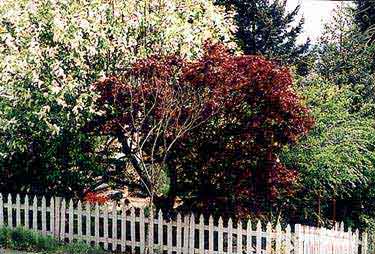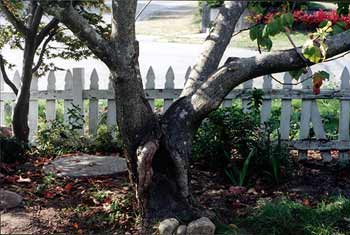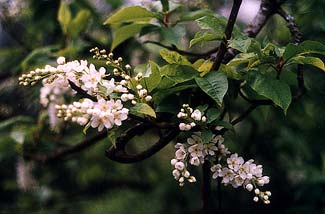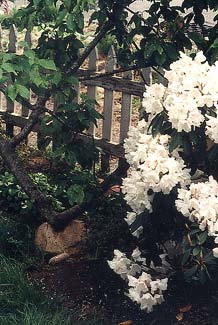 | |
| The chokecherry is the big flowering tree furthest left. To it's right at center stage is Acer palmatum var atropurpureum which is itself old & fairly large but almost dwarfed by the big choke cherry. In in the forground in front of the fence you can make out the skeletal presence of a twelve-foot tall Elkhorn Sumack (Rhus typhina) which in early May still has only leafbuds. The sprays of greenery to the far right behind the maple is a hawthorne tree blending into the fountaining growth over the Cotoneaster Arbor, while barely showing farther in the background is a holly tree . A splash of bright red discernable in the sunlight out the other side of the tunnel between the maple & the chokecherry is a Hino Crimson Azalea. | |
Chokecherry
"The trees in the garden rained flowers.
Children ran there joyously."
-Stephen Crane
(1871-1900)
(1871-1900)
Our native cherry Prunus virginiana has subspecies scattered from coast to coast in North America. The only reason they're named for Virginia is that is where they were first described by pioneer botanists.
It is usually seen as a shrub four to ten feet tall, but as you can see in this photo, if they are old enough, they are substantial trees, 25 to 35 feet high & almost as wide. The top picture was taken in May (2002); it is in full bloom with big bottle-brush racemes of white flowers all over it. These flowers are most extravagant through the first half of May. The early May flower photo lower on this page was taken a bit before the bottlebrushes are fully open, but I liked that portrait best because it also shows the tree's "twists" to its elaborate branchings.
This choke cherry is probably as old as our Edwardian era house, perhaps older; its placement suggests it was intentionally planted, though they are native & perhaps the builders of the house preserved a wild specimen. Alas, choke cherries are not notably long-lived, so we worry about ours with good reason; it is still handsome, but nevertheless approaches the end of its life.
 It sprawls in all directions, the trunk forking about four feet off the ground, forming two trunks at sharp angles, then immediately forking again, so that it has four trunks with multiple thick crooked limbs. The photo of this structure is shown from the morning-sun side in Autumn (2002). Stage right, just out of the photograph's scope, one of main branching trunks takes a sudden bend downward & puts an elbow within inches of the ground, then lifts straight up again. The final picture at the bottom of this page (taken in May) shows the elbow & the nearby Loder's White Rhododendron. We have shoved a large rock under that elbow so the tree is actually resting its elbow on a rock, this to relieve some of the weight & pressure from that unusually long bent limb.
It sprawls in all directions, the trunk forking about four feet off the ground, forming two trunks at sharp angles, then immediately forking again, so that it has four trunks with multiple thick crooked limbs. The photo of this structure is shown from the morning-sun side in Autumn (2002). Stage right, just out of the photograph's scope, one of main branching trunks takes a sudden bend downward & puts an elbow within inches of the ground, then lifts straight up again. The final picture at the bottom of this page (taken in May) shows the elbow & the nearby Loder's White Rhododendron. We have shoved a large rock under that elbow so the tree is actually resting its elbow on a rock, this to relieve some of the weight & pressure from that unusually long bent limb.Just under the main fork of the trunk there was once a third huge branch of forking trunk but that one broke off, oh, who can say, probably decades ago. The tree is very weak at that point & considerably rotted out in the middle. Because the divided trunk grows mostly at long angles in opposing directions, there is considerable weight pulling at the weakened crotch, which is why we braced the lowered elbow with a big rock, knowing that someday the tree will split down the middle, to our sad loss.
 We had a skilled certified arborist (Michael J Swassing) assess the tree for us & he said we might have a decade of beauty left in it, but on the other hand a heavy snowfall or ice could the very next winter cause the tree to split in half at the weak crotch. Fully half the tree could just rip right off & fall to the ground, taking out some shrubs & the fence, but at least the house isn't in its path so that's not a worry for us. The worry is we just love this old tree & will be sad when it does finally split at the center & fall down.
We had a skilled certified arborist (Michael J Swassing) assess the tree for us & he said we might have a decade of beauty left in it, but on the other hand a heavy snowfall or ice could the very next winter cause the tree to split in half at the weak crotch. Fully half the tree could just rip right off & fall to the ground, taking out some shrubs & the fence, but at least the house isn't in its path so that's not a worry for us. The worry is we just love this old tree & will be sad when it does finally split at the center & fall down.So we got all sorts of pointers from the arborist on how to keep it alive & attractive as long as possible. But we were also counselled in essence, "Everything has its own lifespan, & trees no less than all that lives must eventually die. This chokecherry is extremely old & is very close to the end of its natural life."
We were also counselled that all the things people do with a rotting hole in a tree are pretty much worthless & do more harm than good. "Painting" the inside of the hole or even painting a pruned limb or tree injury was once regarded as a good way of keeping insects & rot away, but controlled studies have shown this to be a false hope. Insecticides or fungicides in the hole would be harmful to the roots of the tree itself & shorten rather than extend the life.
 Old methods of filling a tree's hole with cement or with an expanding foam merely traps moisture & speeds up the decay & certainly doesn't keep bugs out. So the best we can do for it is prune as much as is reasonable so there isn't too much unnecessary weight pulling at the crotch & no dead wood sapping the tree's strength; keep grass away from the crown because grass exudes a growth suppressant; fertilize regularly to maximize growth; & keep our fingers crossed that it continues to put on ring growth faster than it rots away from the inside.
Old methods of filling a tree's hole with cement or with an expanding foam merely traps moisture & speeds up the decay & certainly doesn't keep bugs out. So the best we can do for it is prune as much as is reasonable so there isn't too much unnecessary weight pulling at the crotch & no dead wood sapping the tree's strength; keep grass away from the crown because grass exudes a growth suppressant; fertilize regularly to maximize growth; & keep our fingers crossed that it continues to put on ring growth faster than it rots away from the inside.Tragic though that future day will be when this old tree splits & we have no choice but to cut it into fireplace logs, we are hoping some of the other trees are by then large enough to keep that corner of the yard well shaded. Besides the old Japanese Maple there are also in the general vicinity such younger trees as a hornbeam, the elkhorn sumac, a rohani oakleaf beech & a pin oak. These aren't large enough to make up for the chokecherry's wonderful presence now, but if the chokecherry really does make it through one more decade, the recently installed young trees should already be substantial.
I've eaten choke cherries raw & cannot figure out why people claim you can "choak" on them. The pit's too big & they're not tasty as the extremely sweet Eurasian varieties, but they're not grim-tasting as are portugal cherries. The leaves are mildly toxic to humans & some people wrongly believe this toxicity to be in the fruit, but if that were at all true, it would be at such low levels as to be entirely harmless. Cooked & sweetened or spiced, the purple-black cherries are superior for jams, jellies, candies, wines, sauces, relishes, & so on. We got a Choke Cherry Pancake Syrup made by a one-woman-company in Kellogg, Idaho, which was the best mildly sweet syrup I have ever had, being steam-extracted chokecherry sweetened with corn syrup. How sad I was when the woman who was making that excellent syrup retired (in her eighties). We've tried to track down a chokecherry syrup half as good, but have been disappointed by other products. Viki's Montana Classics in Bigfork, MT, has wild chokecherry syrup, pressed chokecherries with white sugar added, & that one is comparatively disappointing, though their wild huckleberry & blackcap syrups are great.
The bark, too, is useful, & has been traditionally regarded as a health tonic prepared as a medicinal brews. Check out the bark portraits on the Chokecherry Page along the Winter Bark Garden Walk.